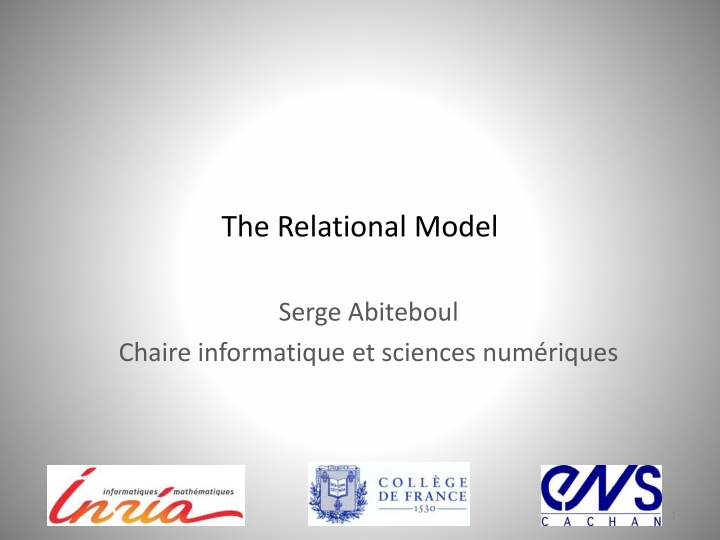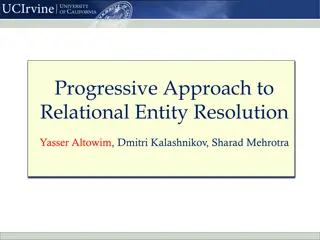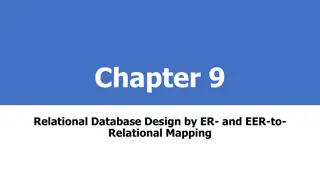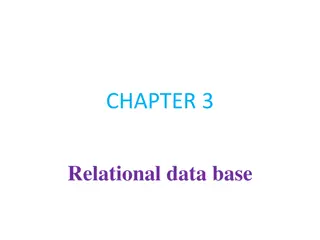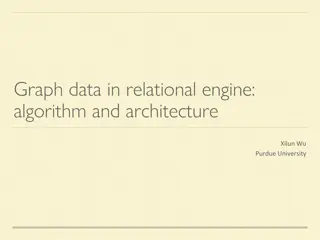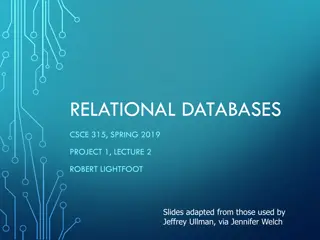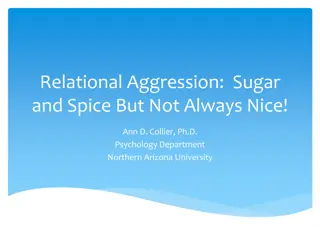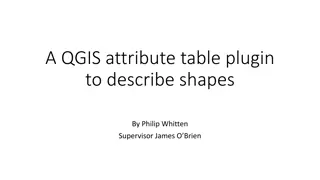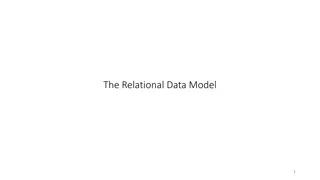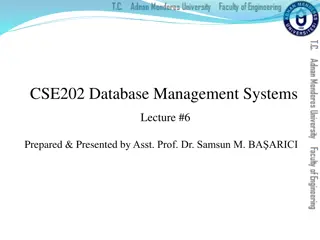The Relational Model and Data Management
In this comprehensive study, delve into the foundational principles of the relational model, database management systems, and the key role they play in mediating between humans and machines. Explore topics such as data models, distributed knowledge bases, and the high-level abstraction provided by formal languages in querying databases. Uncover the complexities and functionalities of managing large volumes of data, emphasizing the significance of abstraction, universality, and independence in optimizing database systems.
Download Presentation

Please find below an Image/Link to download the presentation.
The content on the website is provided AS IS for your information and personal use only. It may not be sold, licensed, or shared on other websites without obtaining consent from the author.If you encounter any issues during the download, it is possible that the publisher has removed the file from their server.
You are allowed to download the files provided on this website for personal or commercial use, subject to the condition that they are used lawfully. All files are the property of their respective owners.
The content on the website is provided AS IS for your information and personal use only. It may not be sold, licensed, or shared on other websites without obtaining consent from the author.
E N D
Presentation Transcript
The Relational Model Serge Abiteboul Chaire informatique et sciences num riques 2/24/2025 2/24/2025 2/24/2025 1 1 1
The course 3 classes on data models The relational model Beyond relational Semantic web 2 cool topics Workflows and active documents Web search engines 3 classes towards distributed knowledge Datalog Distributed data management Distributed knowledge bases 8 seminars 2/24/2025 2
Organization The principles Abstraction Universality Independence Abstraction: Universality: Independence: Optimization, complexity and expressiveness A jewel of databases Conclusion the relational model main functionalities the views revisited 2/24/2025 3
The principles 2/24/2025 4
Database Management System Goal: the management of large amounts of data Large data: database Large software to manage them: DBMS Very complex systems Years of research and development by large groups of researchers/engineers Characteristics of the data Persistence over time (years) Possibly very large (giga, tera, etc.). Possibly distributed geographically Typically shared between many users and programs Typically stored on heterogeneous storage : hard disk, network 2/24/2025 5
Key role: Mediation between human and machines The data management system acts as a mediator between intelligent users and objects that store information t,d ( Film(t, d, Bogart ) S ance(t, s, h) ) O et quelle heure puis-je voir un film avec Bogart? intget(intkey){ inthash=(key%T S);while(table[h ash]=NULL&&ta ble[hash]- >getKey()=key) hash=(hash First order logic: precise and unambiguous syntax and semantics Program: Alice does not want to write it; she does not have to 2/24/2025 6
1stprinciple: abstraction High level data model Definition language for describing the data Manipulation language: queries and updates Definition language based on simple data structure Relations Trees Graphs Formal language for queries Logics Declarative vs. Procedural Graphical languages Complex graphical queries with MS Access 2/24/2025 7
2ndprinciple: universality DBMSs are designed to capture all data in the world for all kinds of applications Powerful languages Rich functionalities: see further To avoid multiplying developments In reality Less structured data are often stored in files Too intense applications require specialized software More and more the case 2/24/2025 8
3rdprinciple: independence ANSI-SPARC Architecture (75): 3 levels Separation into three levels Physical level: physical organization of data on disk, disk management, schemas, indexes, transaction , log Logic: logical organization of data in a schema, query and update processing Externally: views, API, programming environments Independence Physical: We can change the physical organization without changing the logical level Logical: We can evolve the logical level without modifying the applications External: We can change or add views without affecting the logical level Views External level Logical level Physical level 2/24/2025 9
1stprinciple: abstraction High level data model: The relational model 2/24/2025 10
The relational model Codd 1970 Data are represented as tables, namely relations Queries are expressed in relational calculus: declarative Essentially First order logic In practice, a richer model/language: SQL Ordering between tuples, nesting, aggregate functions, nulls Very successful both scientifically and industrially Commercial systems such as Oracle, IBM s DB2 Popular free software like mySQL DBMS on personal computers such as MS Access 2/24/2025 11
Relations 2/24/2025 12
Queries are expressed in relational calculus qHB= { s, h | d, t ( Film(t, d, Humphrey Bogart ) S ance(t, s, h ) } In practice, using a syntax that is easier to understand: SQL: select salle, heure from Film, S ance where Film.titre = S ance.titre and acteur= Humphrey Bogart 2/24/2025 13
Relational algebra Queries are translated in algebraic expressions and evaluated efficiently 2/24/2025 14
The main predecessors Trees Graphs IMS, IBM late 60s, 70s Still very used A hierarchy of records with keys Codasyl A graph of records with keys Supplier(sno, sname, sadd) Supplier(sno, sname, sadd) Part(pno, pname) Little abstraction Languages - Navigational - Procedural - Record-at-at-time Part(pno, pname, qty, price) Order(ono, qty, price) 15 2/24/2025
The main successors: semistructured data models Trees Graphs XML Exchange format for the Web Standard Query languages: Xpath, Xquery Developing very fast Semantic Web & RDF Format for representing knowledge Standard Query language: SPARQL Developing very fast Abstraction Logic foundations High-level languages Next two classes 2/24/2025 16
2ndprinciple: universality Must support many functionalities 2/24/2025 17
Two main classes of applications with important needs for data management OLTP: Online Transaction Processing E-commerce, banking, etc.. Simple transactions, known in advance Very high load in number of transactions per second OLAP: Online Analytical Processing Business intelligence queries Often very complex queries involving aggregate functions Multidimensional queries: e.g., date, country, product Transactional Decision making 2/24/2025 18
Towards universality: more functionalities Applications have essential functional requirements such as : Concurrency and transactions Reliability, security, access control Data distribution Performance and scaling 2/24/2025 19
Towards universality: performance and scaling Many applications have severe performance requirements Response time: The time per operation Throughput: The number of operations per time unit We need to be able to scale Volume of data Volume of requests For this two main tools Optimization Parallelism Terabytes of data Millions of requests per day 2/24/2025 20
Dependencies Laws about the data To protect data To design schemas To optimize queries To explain data Examples S ance[titre] Film[titre] Only known films are shown S ance: salle heure titre Only one movie is shown at a time in a theater Logical formulas t, s, h (S ance(t, s, h ) d, a ( Film(t, d, a) ) ) t, t , s, h (S ance(t, s, h ) S ance(t , s, h ) t=t ) Some of the most sophisticated developments in db theory Inclusion dependency Functional dependencies tgds egds 2/24/2025 21
Dependencies and schema design Use simple dependencies up to complex semantic data models Help choose a better relational schema Person Person Child Child Person Car Car John John Toto Toto John BMW 2chevaux John John Zaza Toto John 2chevaux BMW Sue John Lulu Zaza BMW Sue John Mimi Zaza 2chevaux Sue Lulu Sue Mimi Update anomalies Null values 2/24/2025 22
Concurrency and transactions - ACID Atomicity: the sequence of operations is indivisible; in case of failure, either all operations are completed or all are canceled Consistency: The consistency property ensures that any transaction the database performs will take it from one consistent state to another. (So, consistency states that only consistent data will be written to the database). Isolation: When two transactions A and B are executed at the same time, the changes made by A are not visible to B until transaction A is completed and validated (commit). Durability: Once validated, the state of the database must be permanent, and no technical problem should lead to cancelling of transaction operations 2/24/2025 23
Recovery from failures The DBMS must survive failures A variety of techniques Journal Back-up copies Shadow pages Hot-standby : second system running simultaneously Availability: users should not have to wait beyond what is seen as reasonable for an application 2/24/2025 24
Distributed data Typically the case When integrating several data sources Organizations with many branches Activities involving several companies When using distribution to get better performance Query processing over distributed data Data localization & global query optimization Data fragmentation Typically horizontal partitioning Distributed transactions Two-phase commit Typically too heavy for Web applications 2/24/2025 25
More Security Protect content against unauthorized users (humans or programs) Confidentiality: access control, authentication, authorization Data monitoring Data cleaning Data mining Data streaming Spatiotemporal data Etc. 2/24/2025 26
3rdprinciple: independence Views 2/24/2025 27
Views Definition: Function: Database Database Perhaps the most fundamental concept in databases 0 1 0 2 0 0 1 0 2 View States 0 1 Database states 0 2 1 1 1 1 2 1 1 1 1 2 2/24/2025 28
View definition <state n= Colorado > <resort n= Aspen > <sc> Unisys.com/snow( Aspen ) </sc> <sc> Yahoo.com/GetHotels( Aspen )</sc> </resort> </state> Classical query Define view Implicit definition and recursion Datalog Dependencies (tgds) Mix explicit/implicit: Active XML state n resort resort Colorado n f t g n Aspen 2 meters 1 meter Lake Tahoe 2/24/2025 29
To materialize or not Intentional Materialized Update: do nothing Query: complex Update: propagate Base view: costly view maintenance View base: ambiguous Query: simple Query vs. Update The database trade-off 2/24/2025 30
Integration: view over several bases Intentional: mediator Materialized: warehouse Queries are complex Updates are complex Definitions - Global-as-view: v = (db1, , dbn) Local-as-view: dbi= i(v) Complex logical constraints between the database and the views - for each i - 2/24/2025 31
Optimization, complexity and expressivity 2/24/2025 32
The reasons of the success Calculus: The queries are based on relational calculus, a logical language, simple and understandable by people especially in variants such as SQL. Algebra: A calculus query can easily be translated into an algebraic expression (Codd Theorem) that can be evaluated efficiently. Optimization: The algebra is a limited model of computation (it does not allow computing arbitrary functions). That is why it is possible to optimize algebraic expressions evaluation. Parallelization: Finally, for this language, parallelism allows scaling to very large databases (class AC0). 2/24/2025 33
Rewriting algebraic expressions Projection sur salle, heure S lection acteur = Humphrey Bogart Hashjoin I N D E X Film Film S ance S ance S ance Film (a) For each f in film For each s in s ance do (b) If few tuples pass the selection (c) Using the index complexity in n2 complexity in n complexity constant 2/24/2025 34
A possible query plan (without index) 2/24/2025 35
Optimization Using access structures Hash B-trees Using sophisticated algorithms E.g., merge join Cost evaluation to select an execution plan Problem: search space is too large Technique: Rewrite queries based on heuristics to explore only part of it 2/24/2025 36
Optimization & scaling using parallelism Not all problems can take advantage of parallelism Data management can greatly benefit from parallelism Relational calculus is in AC0 Acyclic join queries are embarrassingly parallelizable Typically divide the data and work separately on pieces Filtre f f f f f 2/24/2025 37
Complexity and expressivity Moshe will speak about that 2/24/2025 38
A jewel of databases Containment of conjunctive queries 2/24/2025 39
Containment of conjunctive queries Q = { x | x ,x ,y ( R(xy) R(x y) R(x ,1)) } I 1 Q V1 2 y x Q(I) 3 2 x y 1 4 1 x 1 10 20 10 x 30 20 V2 30 1 5 5 2/24/2025 40
Another query x ,x ,y ( R(xy) R(x y) R(x ,1) x = x R(z,z) ) Q = x ,y,z ( R(xy) R(x y) R(x ,1) R(z,z) ) I Q 1 2 V1 Q (I) x y 3 2 x y 10 4 1 x 1 10 20 z z 30 20 x V2 30 1 5 5 2/24/2025 41
Question Definition: Q Q if for all I, Q (I) Q(I) Q Q if Q Q and Q Q Problem: given Q , Q, test whether Q Q Central issue for query optimization 2/24/2025 42
If there is a homomorphism from Q to Q, Q Q I 1 2 Q (I) 3 2 10 Q Q 4 1 V H x y x y 10 20 x y x y 30 20 x 1 x 1 30 1 Q(I) z z 5 5 x 10 x HoV 2/24/2025 43
If Q Q, there is a homomorphism from Q to Q Q IQ Identity Q (IQ ) x y x y x y x y x x 1 x 1 z z z z Q Q x Q H Q(IQ ) x y x x y x 1 x 2/24/2025 2/24/2025 44 44
Q Q iff there is a homomorphism from Q to Q The problem is NP-complete 2/24/2025 45
Disjunction Thm: Q i Qjiff for each i, there exists j, Q i Qj ) Suppose for each i, there exists j, Q i Qj Let I be some instance: consider some I; there exists j, Q i(I) Qj(I) Q i(I) Qj(I); so, Q i(I) Qj(I); so, Q i Qj ) Suppose Q i Qj (to simplify assume wlg they are Boolean queries) Consider some i and the instance IQ i Q i(IQ i) not empty; so Qj(IQ i) not empty; For some j, Qj(IQ i) not empty; So there is a homomorphism from Qjto Q i 2/24/2025 46
Beyond Negation: containment of FO queries is undecidable co r.e. for finite relations (r.e. for arbitrary relations) Recursion: containment of datalog is undecidable Decidable for monadic datalog Undecidable for monadic datalog over trees or strings (for infinite alphabet) Tableau homorphism is a particular case of subsumption in resolution theorem proving 2/24/2025 47
Conclusion 2/24/2025 48
Relational databases Very successful in industry Lots of results in academia 2/24/2025 49
Blend with other technologies Logic programming Production rule systems Object-oriented languages Workflows Clusters of machines Peer-to-peer architecture 2/24/2025 50
